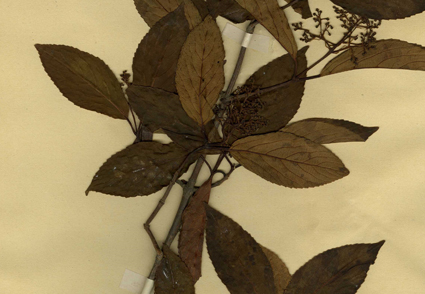Abstract
Examination of the protologues of Viburnum henryi, V. brachybotryum var. tengyuehense, V. theiferum and V. ternatum revealed that at least two gatherings were mentioned as types for every one of them, making it necessary to designate a lectotype for each of the 4 names.
References
<p>Angiosperm Phylogeny Group (2009) An update of the angiosperm phylogeny group classification for the orders and families of flowering plants: APG III. <em>Botanical Journal of the Linnean Society</em> 161 (2): 105–121. https://doi.org/10.1111/j.1095-8339.2009.00996.x</p>
<p>Angiosperm Phylogeny Group (2016) An update of the Angiosperm Phylogeny Group classification for the orders and families of flowering plants: APG IV. <em>Botanical Journal of the Linnean Society</em> 181 (1): 1–20. https://doi.org/10.1111/boj.12385</p>
<p>Cronquist, A. (1988) <em>Evolution and Classification of Flowering Plants</em>, vol. 2. The New York Botanical Garden, New York, pp. 513–517.</p>
<p>Dilsha, M.V. & Satheesh, G. (2021) Lectotypification of five names in the genus <em>Blumea</em> (Asteraceae). <em>Webbia</em> 76 (2): 281–288. https://doi.org/10.36253/jopt-10530</p>
<p>Engler, A. & Diels, L. (1936) <em>Syllabus der Pflanzenfamilien</em>, vol. 11. Gebruder Born traeger, Berlin, 419 pp.</p>
<p>Forbes, F.B. & Hemsley, W.B. (1888) An Enumeration of all the plants known from China Proper, Formosa, Hainan, Corea, the Luchu Archipelago, and the Island of Hongkong, together with their distribution and synonymy. <em>Botanical Journal of the Linnean Society </em>23: 329–400. https://doi.org/10.1111/j.1095-8339.1888.tb00535.x</p>
<p>Hance, H.F. (1882) Spicilegia florae sinensis: diagnoses of new, and habitats of rare or hitherto unrecorded, Chinese Plants. <em>Journal of Botany, British and Foreign</em> 20: 1–395.</p>
<p>Hsu, P.S. (1966) Some new plants of Chinese <em>Viburnum</em>. <em>Acta Phytotaxonomica Sinica</em> 11 (1): 67–83.</p>
<p>Hutchinson, J. (1973) <em>The families of Flowering Plants</em>, vol. 3. The Clarendon Press, Oxford, 968 pp.</p>
<p>Hsu, P.S. (1988) <em>Viburnum</em> Linnaeus. <em>In</em>: Hsu, P.S. (Ed.) <em>Flora Reipublicae Popularis Sinicae</em>, vol. 72. Science Press, Beijing, pp. 12–104.</p>
<p>Linnaeus, C. (1753) <em>Species Plantarum</em>, vol. 1. Laurentius Salvius, Stockholm, 267 pp.</p>
<p>Rehder, A. (1907) <em>Trees and shrubs: illustrations of new or little known ligneous plants, prepared chiefly from material at the Arnold Arboreum</em>, vol. II. The Riberside Press, Cambridge, Massachusetts, 45 pp.</p>
<p>Rehder, A. (1935) Notes on the ligneous plants described by Léveillé from Eastern Asia. <em>Journal of the Arnold Arboretum</em> 16 (3): 311–340. https://doi.org/10.5962/p.324579</p>
<p>Smith, W.W. (1916) Diagnoses specierum novarum in herbario Horti Regii Botanici Edinburgensis cognitarum. (Species chinenses). <em>Notes from the Royal Botanic Garden Edinburgh</em> 9 (42): 71–144.</p>
<p>Turland, N.J., Wiersema, J.H., Barrie, F.R., Greuter, W., Hawksworth, D.L., Herendeen, P.S., Knapp, S., Kusber, W.H., Li, D.Z., Marhold, K., May, T.W., McNeill, J., Monro, A.M., Prado, J., Price, M.J. & Smith, G.F. (Eds.) (2018) <em>International Code of Nomenclature for algae, fungi, and plants (Shenzhen Code) adopted by the Nineteenth International Botanical Congress Shenzhen, China, July 2017</em>. Regnum Vegetabile 159. Koeltz Botanical Books, Glashütten. https://doi.org/10.12705/Code.2018</p>
<p>Wagensommer, R.P., Perrino, E.V., Albano, A., Medagli, P. & Passalacqua, N.G. (2016) Lectotypification of four Lacaita’s names in the genus <em>Centaurea</em> (Asteraceae). <em>Phytotaxa</em> 269 (1): 54–58. https://doi.org/10.11646/phytotaxa.269.1.7</p>
<p>Yang, Q.E. & Malécot, V. (2011) <em>Viburnum</em> Linnaeus. <em>In</em>: Wu, Z.Y., Raven, P.H. & Hong, D.Y. (Eds.) <em>Flora of China</em>, vol. 19. Science Press, Beijing & Missouri Botanical Garden Press, St. Louis, pp. 570–611.</p>
<p>Angiosperm Phylogeny Group (2016) An update of the Angiosperm Phylogeny Group classification for the orders and families of flowering plants: APG IV. <em>Botanical Journal of the Linnean Society</em> 181 (1): 1–20. https://doi.org/10.1111/boj.12385</p>
<p>Cronquist, A. (1988) <em>Evolution and Classification of Flowering Plants</em>, vol. 2. The New York Botanical Garden, New York, pp. 513–517.</p>
<p>Dilsha, M.V. & Satheesh, G. (2021) Lectotypification of five names in the genus <em>Blumea</em> (Asteraceae). <em>Webbia</em> 76 (2): 281–288. https://doi.org/10.36253/jopt-10530</p>
<p>Engler, A. & Diels, L. (1936) <em>Syllabus der Pflanzenfamilien</em>, vol. 11. Gebruder Born traeger, Berlin, 419 pp.</p>
<p>Forbes, F.B. & Hemsley, W.B. (1888) An Enumeration of all the plants known from China Proper, Formosa, Hainan, Corea, the Luchu Archipelago, and the Island of Hongkong, together with their distribution and synonymy. <em>Botanical Journal of the Linnean Society </em>23: 329–400. https://doi.org/10.1111/j.1095-8339.1888.tb00535.x</p>
<p>Hance, H.F. (1882) Spicilegia florae sinensis: diagnoses of new, and habitats of rare or hitherto unrecorded, Chinese Plants. <em>Journal of Botany, British and Foreign</em> 20: 1–395.</p>
<p>Hsu, P.S. (1966) Some new plants of Chinese <em>Viburnum</em>. <em>Acta Phytotaxonomica Sinica</em> 11 (1): 67–83.</p>
<p>Hutchinson, J. (1973) <em>The families of Flowering Plants</em>, vol. 3. The Clarendon Press, Oxford, 968 pp.</p>
<p>Hsu, P.S. (1988) <em>Viburnum</em> Linnaeus. <em>In</em>: Hsu, P.S. (Ed.) <em>Flora Reipublicae Popularis Sinicae</em>, vol. 72. Science Press, Beijing, pp. 12–104.</p>
<p>Linnaeus, C. (1753) <em>Species Plantarum</em>, vol. 1. Laurentius Salvius, Stockholm, 267 pp.</p>
<p>Rehder, A. (1907) <em>Trees and shrubs: illustrations of new or little known ligneous plants, prepared chiefly from material at the Arnold Arboreum</em>, vol. II. The Riberside Press, Cambridge, Massachusetts, 45 pp.</p>
<p>Rehder, A. (1935) Notes on the ligneous plants described by Léveillé from Eastern Asia. <em>Journal of the Arnold Arboretum</em> 16 (3): 311–340. https://doi.org/10.5962/p.324579</p>
<p>Smith, W.W. (1916) Diagnoses specierum novarum in herbario Horti Regii Botanici Edinburgensis cognitarum. (Species chinenses). <em>Notes from the Royal Botanic Garden Edinburgh</em> 9 (42): 71–144.</p>
<p>Turland, N.J., Wiersema, J.H., Barrie, F.R., Greuter, W., Hawksworth, D.L., Herendeen, P.S., Knapp, S., Kusber, W.H., Li, D.Z., Marhold, K., May, T.W., McNeill, J., Monro, A.M., Prado, J., Price, M.J. & Smith, G.F. (Eds.) (2018) <em>International Code of Nomenclature for algae, fungi, and plants (Shenzhen Code) adopted by the Nineteenth International Botanical Congress Shenzhen, China, July 2017</em>. Regnum Vegetabile 159. Koeltz Botanical Books, Glashütten. https://doi.org/10.12705/Code.2018</p>
<p>Wagensommer, R.P., Perrino, E.V., Albano, A., Medagli, P. & Passalacqua, N.G. (2016) Lectotypification of four Lacaita’s names in the genus <em>Centaurea</em> (Asteraceae). <em>Phytotaxa</em> 269 (1): 54–58. https://doi.org/10.11646/phytotaxa.269.1.7</p>
<p>Yang, Q.E. & Malécot, V. (2011) <em>Viburnum</em> Linnaeus. <em>In</em>: Wu, Z.Y., Raven, P.H. & Hong, D.Y. (Eds.) <em>Flora of China</em>, vol. 19. Science Press, Beijing & Missouri Botanical Garden Press, St. Louis, pp. 570–611.</p>


